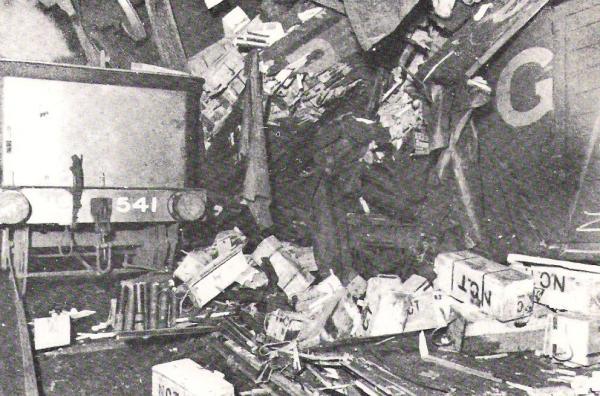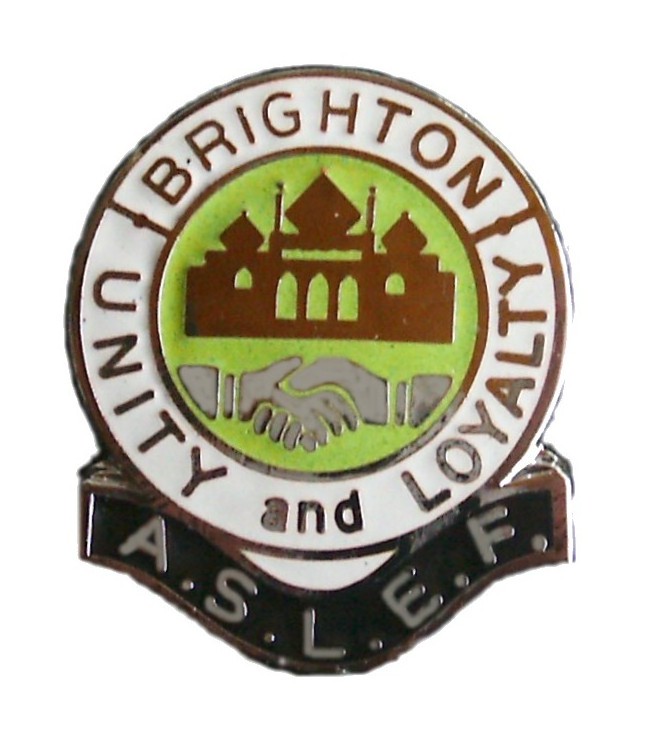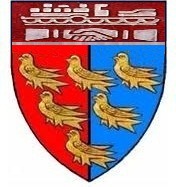REDHILL TUNNEL

PHOTOGRAPHER UNKNOWN
A triple collision occurred in Redhill tunnel (Sand-hole) during the early hours of 18th April, 1918, when Driver Roberts and his
Fireman Howard, when their K Class 2-6-0 engine No. 340, were working the 2.10 a.m. up goods ex-Eastbourne (59 wagons
and a brake van) had been stopped at the advance starting signal after passing Earlswood Junction Signal box, and on getting
away the Driver Roberts snatched the train, breaking a coupling. Driver Roberts and his engine and its section of the goods
wagons passed through the tunnel, where it was followed by the remainder of the wagons, which came to rest some hundred
yards from the entrance, where they were run into by Driver Sharp’s Class C2X engine No. 541 at the head of the 11.40 goods
ex-Portsmouth (38 wagons and a brake van).
Before any warning could be given Driver Hunt and his Fireman Mapp, was approaching with Class C2 No. 536, with the 4.00
a.m. Lillie Bridge – Newhaven ammunition train (39 wagons) entered the tunnel on the down line under clear signals and
crashed into the wreckage. The of this train was derailed and a length of the tunnel filled to the crown with highly explosive
debris but possibly through lack of air nothing caught fire, and by working day and night breakdown gangs cleared the lines in
forty hours. No one was seriously injured, and 26 wagons completely destroyed. At the inquiry, Guard Austin of the Eastbourne
goods and Signalman Tawes came in for much adverse comment, the former for sitting in his van inside Redhill tunnel from
5.04 to 5.13 a.m. without attempting to protect his train, and the latter for passing no. 340 and its part- train to star lane section
without observing the lack of a brake van or red tail lamp. Either, by rapid action and obeyance of the Company’s rules, could
have minimized or stopped the accident.
ENQUIRY INTO THE DERAILMENT AT
REDHILL TUNNEL ON THE 18th APRIL 1918
INVOLVING ENGINEMEN
DRIVER HUNT & FIREMAN MAPP (Battersea),
DRIVER SHARP & FIREMAN KEATS (Battersea),
DRIVER ROBERTS & FIREMAN HOWARD (Depot Unknown)
EXTRACT & ADAPTED FROM THE REPORT
By Colonel J.W. PRINGLE
On the 18th of April, about 5.15 a.m., near Earlswood, on the London, Brighton and South Coast Railway, a up goods train
(2.10 a.m. from Eastbourne) divided, and the rear part came to a standstill inside Redhill tunnel. The following up goods train
(11.40 pm. ex Portsmouth) collided with the standing vehicles, and derailed them. The engine and first three trucks of the second
goods train were also derailed. Before warning could be given a special down goods train (4.0 a.m. from Lillie Bridge) ran into
the obstruction, with the result that practically the whole of this train was also derailed. A length of feet of the tunnel was filled
to the crown with trucks and debris Both engines were badly damaged, and 26 wagons either destroyed or more or less broken
up. Fortunately, although two guards were cut and bruised, no fatality or even serious injury resulted.
The three trains concerned were made up as follows :-Eastbourne Goods.-EngineNo. 340 (type 2-6-0) and 6 wheeled tender,
with 10 loaded and 49 empty trucks, and a 20 ton brake van. Portsmouth Goods.-Engine No. 541 (type 0-6-0) and 6-wheeled
tender, with 38 goods vehicles and brake van. Lillie Bridge Goods.-Engine No. 536 (0-6-0) and 6-wheeled tender, with 39
loaded vehicles and brake van.
All the engines were fitted with the air (Westinghouse)pressure brake, working blocks the coupled wheels, and all wheels of the
tender.
Description.
Redhill Tunnel, in which these collisions occurred, is situated about half a mile north Earlswood Station on the Company's main
Brighton road. The signal-boxes concerned are Earlswood Junction, on the south, and Quarry Intermediate, on the north.
Worsted Green signal-box forms an additional block post by day time, but is switched out at night.
Quarry signal-box is situated in cutting with slopes of 1to13. This cutting extends 200 yards northward to the south face of
Merstham tunnel, and 260 yards southward. From the point where the cutting ends, the railway is laid on curved embankment to
within a few hundred yards of the north face of Redhill tunnel. This tunnel is practically straight and, when it is free of smoke, it
is possible to see through it from end to end.
1. The statements of the men concerned in this case do not conflict on any point of importance.
The Eastbourne up goods train, after passing Earlswood Junction signal-box, was stopped at the advance starting signal. In
this position the engine was some 80 yards from the tunnel entrance, and about 50 wagons were standing (probably with
buffers) behind the engine on the falling gradient. Goods guard Austin estimates that only three or four of the rear vehicles
stood on the rising gradient (see description); but, judging from the distance between the signal post and the gradient post in
rear, it is probable that there were nine or ten vehicles on the rising gradient. Austin also states that these rear vehicles
stood, with buffers closed, and that it was not necessary for him to use his hand brake to keep them in that position.
At 4.56 a.m. the signal was lowered and the train started. Evidently some snatch on the couplings occurred, for the train divided
owing to breakage of a link on a private own’s wagon (Stevenson Clarke, No. 8663). The severed portion, consisting of three
trucks and 20-ton van, followed the front part of the train into the tunnel, and came to
rest with the rear buffers about 100 yards inside. There is a change of gradient 77 yards inside the tunnel, from practically level
to rising 1- in 162. The detached vehicles, having regard to the distance they travelled (about;500 yds.), must, I think, have
come to rest about 4.59 a m . In accordance with t.he signalman’s bookings, the front portion of this train passed Quarry signal-
box at 5.9 a.m.
The following up goods (from Portsmouth); was put into section to Quarry from Earlswood Junction by signalman Scollick also
at 5.9 a.m. This train was checked at Earlswood Junction by Signals, but was not, actually stopped. It is probable that the
collision with the vehicles standing in the tunnel took place about, two or three minutes. later; i.e., about 5.12 a.m., Driver
Sharp, and. Fireman Keats. of the: Portsmouth train state that the tunnel was full of steam and smoke, which prevented them
obtaining any view of the, side tail lights marking the obstruction. The regulator was open and the brake unapplied at the
moment of impact. The result of the collision was to throw the four goods vehicles off the rails, foul of the down road, and to
deraiI the engine and some trucks of the Portsmouth train.
The 4.a.m. down goods from Lillie Bridge passed Quarry signal-box at 5.9. a.m, and the speed of the train on entering the north
end of Redhill tunnel is estimated by different witnesses at from 20 to 30 miles an hour. It is probable, therefore, that the engine
reached the obstruction abut six minutes after passing Quarry signal-box i.e. about 5.15 a.m. The evidence proves that driver
Hunt of the down goods train sounded his whistle on entering the tunnel and that heard the sound of the whistling made by
Driver Sharp after the collision had occurred. He applied the brake on his engine shortly before striking the obstacle; but the
atmosphere was so thick that neither he or his fireman (Mapp) was able to the funnel of their own engine.
II. It is the duty--Rule 171(h) -- of the engine drives, when a goods train starts from a signal where it has been stopped on its
journey, to satisfy himself that his fireman has exchanged hand signals with the guard,in rear of the train, so that they may be
sure they have the whole of the train with them. If necessary, the engineman must whistle to attract the guard's attention. Driver
Roberts and fireman Howard, enginemen of the up Eastbourne train, were aware of this obligation. They experienced no snatch
on starting from rest at the Earlswood Junction advance signal, and had no opportunity - owning to curvature of the line -
before the engine entered the tunnel, of exchanging signals with the guard. After emerging from the tunnel, they were on the
look-out for such an opportunity; but, owing to heaviness of the atmosphere and the manner in which the steam was beating
down past the engine, were unable to see so far as the end of the train.
Guard Austin experienced a slight snatch as the train started, but was unable to see the engine before it disappeared into, the
tunnel. He thought the brake was, following the train properly, and,even if he had been able to see the fireman; would have
given him a green light to indicate these was nothing, amiss. He thought, when his brake van came to rest, he was near the
middle of the tunnel, and there was no movement of the van backwards. He waited in his vehicle from five to seven minutes, but
was unable to hear any sound, and was quite at a loss to know what had happened. He then took his lamp and, getting out of the
van, went forward, to find a breakaway had occurred, and that there were only three vehicles in front of his van. He returned
and applied his hand-brake, and was getting out detonators with the object of protecting the standing vehicles when the
collision occurred. He did not look at, his watch, and it is impossible, therefore, that more than five to seven minutes elapsed
before he took action. He does not recall what happen after the collision, and was fortunate to escape serious injury.
Driver Sharp and Fireman Keats did what was possible to furnish protection. The latter attempted to gek past the,wreckage in
order to lay detonators on the down road, but without success, until the near approach of the down train forced him to desist.
lll. Rule 126 lays down the necessity for a tail lamp on every train, in order to furnish evidence to the signalmen that no portion
of the train has become detached. Regulation (10a) f or Train Signalling on double lines of railway also enacts that “the ‘train
out of section signal must not be given to the signal-box in the rear until the last vehicle of the
train, with tail lamp attached, has passed the signal-box." It was the duty of George Towes signalman at Quarry box, to act in
accordance with this Rule. He saw the Eastbourne goods train pass his post at 5.10 a.m., and is confident that he saw the brake
van but admits he did not see any side tail-light. Goods trains are distinguished by a tail lamp on each side of the brake van.
Towes telephoned to the signal-box in advance (Star Lane) to watch if there was al amp at the end of the Eastbourne train, and
at 5.16 a.m. received the reply that there was no brake van on the train, and therefore no tail lamp. wes complains that in the
cutting in which his signal-box is situated it is difficult to observe passing trains properly, owing to smoke and steam. This is
more particularly Icase if a down train-as happened in this case-passes out of Merstham tunnel immediately before an up train
passes, as the smoke and steam follow the down train out of the tunnel. He also complains that the paint work on the windows
of his signal-box obstructs the vision.
IV. I n respect of the duty laid upon the enginemen and goods guard of the Eastbourne train by Rule 171(h), I do not think that
Roberts, Howard or Austin can be fairly held to have been negligent. The tunnel is so close to the advance starting signal that
the whole train could hardly have been much more than on the move before the engine disappeared into the tunnel. After
emerging from the tunnel, the railway for two miles is on embankment curved in turn eastward and westward, and the
opportunity for exchanging hand-signals, with such an alignment and formation, is normally good. But it is undeniable that
steam, in the absence of any side wind, will seriously obstruct the view that enginemen have to the rear, especially when the
atmosphere is damp. I do not therefore hold the enginemen responsible for failure to detect the break-away, which was at least
400 yards behind the engine.
V. On the other hand, signalman Towes cannot be excused for negligence in respect of he duties imposed upon him for the
observance of tail lights. He admits he saw no tail lamp at the end of the Eastbourne train, and should therefore have sent the
“Stop and examine signal to Star-Lane, and the “Obstruction danger " signal to Earlswood Junction. Instead of this, he sent the
ordinary ”Train out of section” signal to Earlswood, and accepted with “Full line clear “ the following up train without word
or inquiry of any sort. The fact that the last ten or more vehicles on the portion of the Eastbourne train which passed him were
trucks, and not box vans, clearly show that he was not carrying out his duty of observation properly.
The conduct of goods guard Austin in taking no action for probably ten minutes after the brake van came to rest in the tunnel is
also reprehensible. He admits that there no sound in the tunnel, as might be expected if the engine had failed, and no noise from
buffers knocking, or other vehicular movement. In such circumstances to allow more than two or three minutes to elapse before
taking action to find out what had happened and to protect the line, is evidence of careless behaviour and want of attention to
duty. The fact that Austin’s journal contains no entries subsequent to the time the train passed Lewes is further proof in this
direction. With full ten minutes available for action, there was sufficient time, if he had been duly alert, to have stopped the
Portsmouth train before the collision occurred.
The responsibility for the accident rests, in my opinion, equally upon Towes and Austin. They had been at work 7 and 8 3/4
hours respectively, and do not appear to have had excessive hours of duty during the preceding week.
VI. The tunnel was cleared of debris and opened to traffic within forty hours of the accident. This speaks well for the manner in
which the emergency was met, and for the excellent work done by the breakdown gangs in so conhed a space, and in trying and
dangerous conditions.
Possibility of an explosion inside Redhill tunnel conjures up thoughts of the devastation caused by the ammunition ship
conflagration at Halifax, Nova Scotia during the first world war, when an oil tanker and an explosives ship collided in the
harbour, caught fire, and blew up wrecking the harbour and much of the town.
Loco Sheds of Enginemen involved are not know at this moment.


